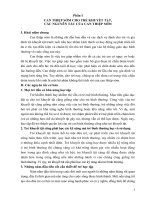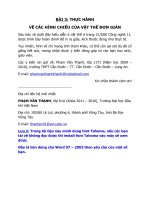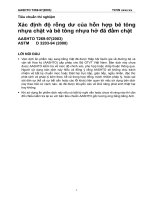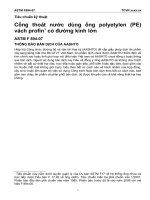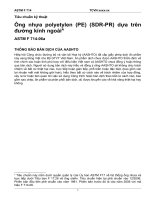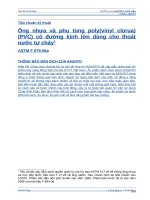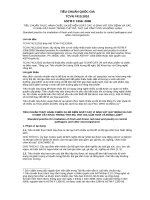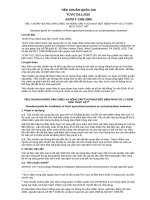Astm f 676 97 (2003)
Bạn đang xem bản rút gọn của tài liệu. Xem và tải ngay bản đầy đủ của tài liệu tại đây (35.17 KB, 3 trang )
Designation: F 676 – 97 (Reapproved 2003)
Standard Test Method for
Measuring Unsaturated TTL Sink Current1
This standard is issued under the fixed designation F 676; the number immediately following the designation indicates the year of
original adoption or, in the case of revision, the year of last revision. A number in parentheses indicates the year of last reapproval. A
superscript epsilon (e) indicates an editorial change since the last revision or reapproval.
4. Significance and Use
4.1 Unsaturated sink current is a special parameter that is
closely related to the gain of the output transistor of TTL
circuits. This parameter is particularly useful in evaluating
neutron degradation in TTL devices because it changes
smoothly as the device degrades, and exhibits larger changes at
moderate radiation levels than the standard electrical parameters.
1. Scope
1.1 This test method covers the measurement of the unsaturated sink current of transistor-transistor logic (TTL) devices
under specified conditions.
1.2 Units—The values stated in the International System of
Units (SI) are to be regarded as standard. No other units of
measurement are included in this standard.
1.3 This standard does not purport to address all of the
safety concerns, if any, associated with its use. It is the
responsibility of the user of this standard to establish appropriate safety and health practices and determine the applicability of regulatory limitations prior to use.
5. Interferences
5.1 Long pulses will cause many current probes to saturate.
The current-time rating of the probe must not be exceeded.
5.2 Valid measurements will not be obtained unless the
voltage applied to the output is sufficient to bring the output
transistor out of saturation.
5.3 If the voltage applied to the output exceeds 1.5 V, errors
may result. Some devices may change state. Some devices
have internal diode connections which will conduct if the
output exceeds 1.5 V.
5.4 High contact resistance will cause the voltage at the
device to differ from the applied voltage. Kelvin contacts may
be required.
5.5 Device temperature will affect this measurement. Pulse
width and duty cycle must be maintained low enough that the
test does not cause heating of the device.
2. Referenced Documents
2.1 ASTM Standards:
E 178 Practice for Dealing with Outlying Observations2
3. Summary of Test Method
3.1 Input and bias voltage levels and any required input
signals are applied to the device under test to put the output to
be tested in the low-level state. Voltage pulses of sufficient
magnitude to pull the output transistor out of saturation are
applied to the output pin under test. The corresponding current
pulses are measured.
3.2 The following test conditions are not specified by the
test method and shall be agreed upon by the parties to the test:
3.2.1 The output pin(s) to be tested,
3.2.2 Ambient temperature range,
3.2.3 Supply voltage(s) to be used,
3.2.4 Input sequence to be applied before the device output
is pulsed,
3.2.5 Pulse voltage to be applied to the output pin under test,
3.2.6 Duty cycle and duration of the applied pulses, and
3.2.7 Accuracy and tolerances required for supply voltage(s), input voltages, pulse voltage, current measurement,
duty cycle, and pulse-width.
6. Apparatus
6.1 Pulse Generator, capable of supplying the current
required by the output pin under test at the agreed-upon
voltage.
6.2 Oscilloscope, or Digital Recorder, dual-beam or dualtrace, meeting the following requirements:
6.2.1 Bandwidth of 30 MHz or greater.
6.2.2 Deflection factor range of 5 mV per division to 1 V per
division.
6.3 Termination RT, suitable for the current probe used.
6.4 Current Probe, meeting the following requirements:
6.4.1 Rise time less than 10 % of the agreed-upon pulse
width.
6.4.2 Droop no more than 5 % of the agreed-upon pulse
width.
1
This test method is under the jurisdiction of ASTM Committee F01 on
Electronics and is the direct responsibility of Subcommittee F01.11 on Quality and
Hardness Assurance.
Current edition approved Dec. 10, 1997. Published March 1998. Originally
published as F 676 – 80. Last previous edition F 676 – 93.
2
1983 Annual Book of ASTM Standards, Vol 14.02.
Copyright © ASTM International, 100 Barr Harbor Drive, PO Box C700, West Conshohocken, PA 19428-2959, United States.
1
F 676 – 97 (2003)
6.4.3 Current-time rating sufficient to avoid saturation. See
4.1.
6.5 Power Supplies and Pulse Generators, as required to
establish bias and input conditions for the test.
6.6 Oscilloscope Probe, having an input impedance of 1
MV or greater in parallel with 25 pF or less.
6.7 Miscellaneous Circuit Components, to be used as required to set up the test circuit. See Fig. 1. All components
shall be of a quality customarily used in electronic circuit
fabrication.
6.8 Temperature-Measuring Device, capable of measuring
the temperature in the vicinity of the device under test to an
accuracy of 6 1°C at the temperature specified for the
measurement.
8. Procedure
8.1 Assemble the circuit shown in Fig. 1. Leave the output
pin pulse generator disconnected. Connect the 0.1-µF capacitor
as close as possible to device socket.
8.2 Turn on all electronic equipment and allow to warm up
for a minimum of 5 min or as required by the manufacturer.
8.3 Adjust power supply and pulse generator outputs to zero
volts.
8.4 Insert the device to be tested in the test socket.
8.5 Adjust the specified power supply voltages and perform
the specified input sequence.
8.6 Record ambient temperature in the vicinity of the device
under test.
8.7 Adjust the output pin pulse generator duty cycle and
pulse width to their agreed-upon values and reset to zero.
8.8 Connect the output pin pulse generator to the test circuit
and slowly increase the amplitude of the output pin pulse
generator until the agreed-upon voltage pulse is obtained.
8.9 Adjust the oscilloscope gain controls so that both the
current and voltage signals are at least 3 divisions in amplitude.
7. Sampling
7.1 This test method determines the properties of a single
specimen. If sampling procedures are used to select devices for
test, the procedures shall be agreed upon by the parties to the
test.
FIG. 1 Test Circuit for Sink Current Measurement
2
F 676 – 97 (2003)
Read and record the amplitude of the current and voltage
pulses from the oscilloscope displays.
9.1.8 Pin tested,
9.1.9 Input test sequence, and
9.1.10 Pulse amplitude used and corresponding current
measured.
9. Report
9.1 The report shall contain as a minimum:
9.1.1 Identification of operator,
9.1.2 Date of test,
9.1.3 Type and identification of the device under test,
including date code, vendor, and package type,
9.1.4 Value of power supply voltage(s) used,
9.1.5 Duty cycle and pulse width,
9.1.6 Current probe type (model and manufacturer),
9.1.7 Ambient temperature,
10. Precision and Bias
10.1 An interlaboratory test of the method was conducted
among six laboratories, each with five devices from a total of
five different device types.
10.2 The Tn criteria for single samples of Practice E 178,
was applied to the datum from one laboratory for one device.
The value reported for this device failed the criterion for
significance at the level of 5 %. On this basis, the datum was
deleted from the analysis of the test.
10.3 The analysis of the remaining data involved the calculation of the mean values and percent standard deviations of the
unsaturated sink currents reported. The average of the percent
standard deviations of the currents reported by the participating
laboratories for all (25) devices was found to be 2.55 % with a
standard deviation of 0.68 %. The results of other calculations
are summarized in Table 1.
TABLE 1 Precision and Bias Data
Device Type
SN7400J
DM74L00N
F74H00DC
DM74L03N
74S03/9S03DC
Range of Device Current
Means, mA
Interlaboratory
Range of Percent Standard
Deviation of
Current
Means, %
Average
Standard Deviation,
%
52.4 to 66.8
7.41 to 8.66
47.7 to 153
9.42 to 10.7
89.0 to 103
2.70 to 3.30
1.72 to 3.04
1.29 to 3.61
1.59 to 2.11
2.82 to 3.45
2.97
2.56
2.30
1.84
3.10
11. Keywords
11.1 hardness assurance; neutron degradation; sink current;
transistor-transistor logic (TTL)
ASTM International takes no position respecting the validity of any patent rights asserted in connection with any item mentioned
in this standard. Users of this standard are expressly advised that determination of the validity of any such patent rights, and the risk
of infringement of such rights, are entirely their own responsibility.
This standard is subject to revision at any time by the responsible technical committee and must be reviewed every five years and
if not revised, either reapproved or withdrawn. Your comments are invited either for revision of this standard or for additional standards
and should be addressed to ASTM International Headquarters. Your comments will receive careful consideration at a meeting of the
responsible technical committee, which you may attend. If you feel that your comments have not received a fair hearing you should
make your views known to the ASTM Committee on Standards, at the address shown below.
This standard is copyrighted by ASTM International, 100 Barr Harbor Drive, PO Box C700, West Conshohocken, PA 19428-2959,
United States. Individual reprints (single or multiple copies) of this standard may be obtained by contacting ASTM at the above
address or at 610-832-9585 (phone), 610-832-9555 (fax), or (e-mail); or through the ASTM website
(www.astm.org).
3
